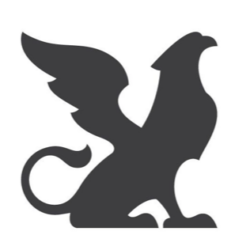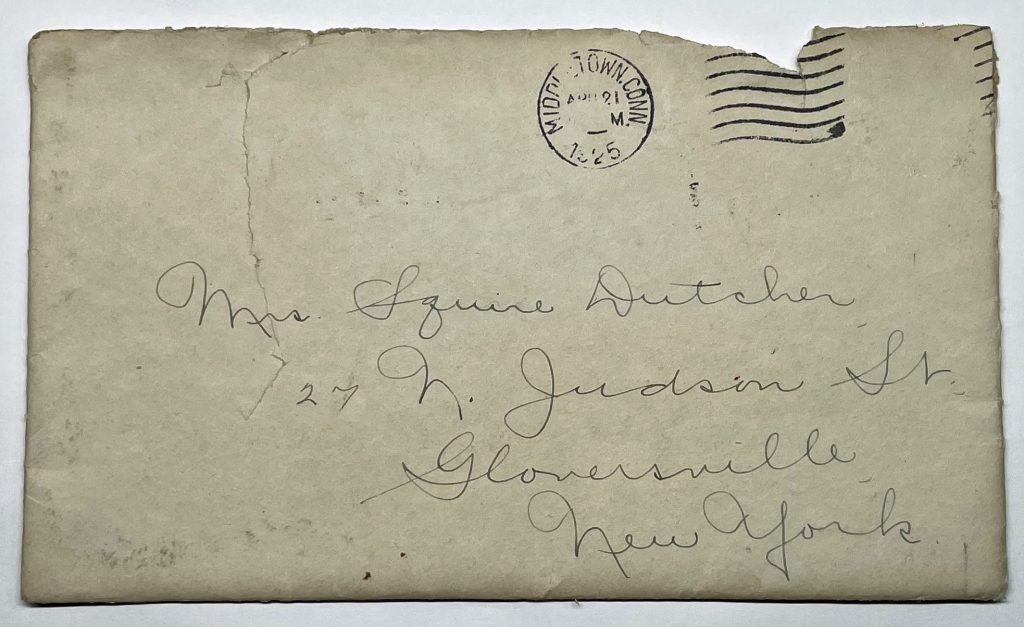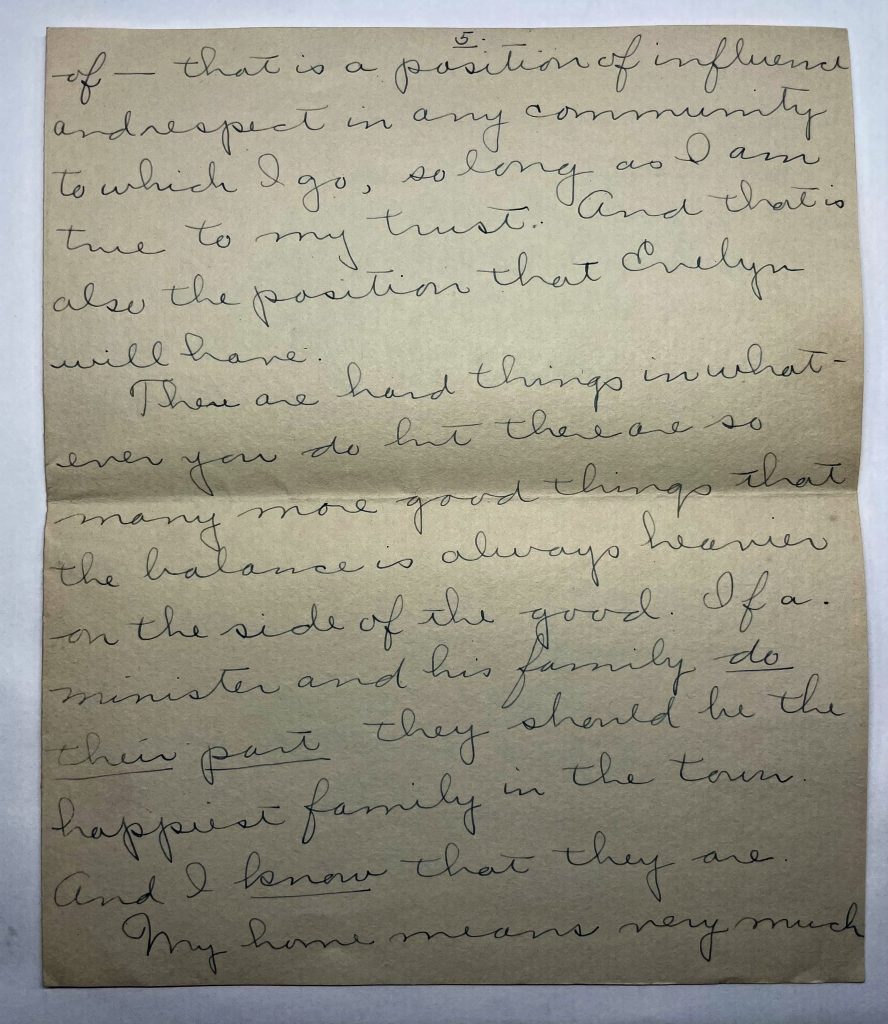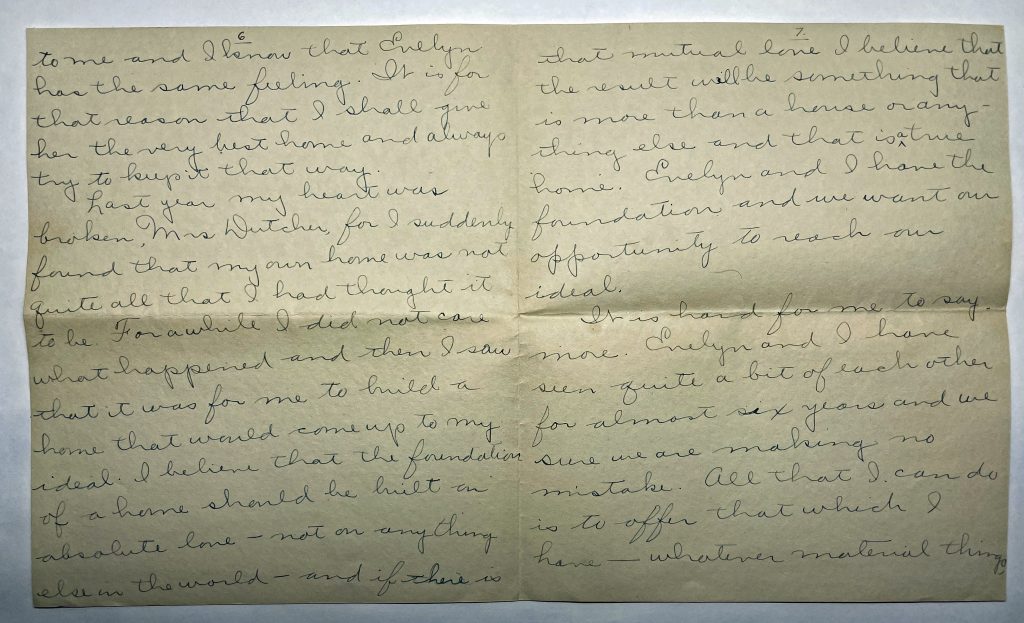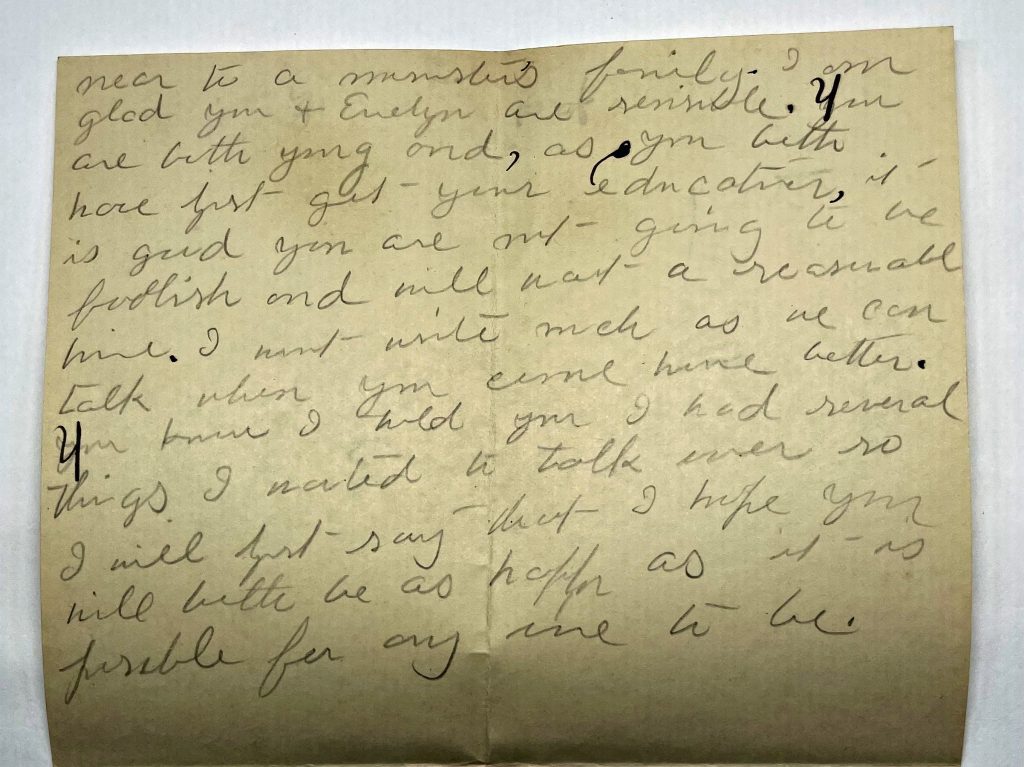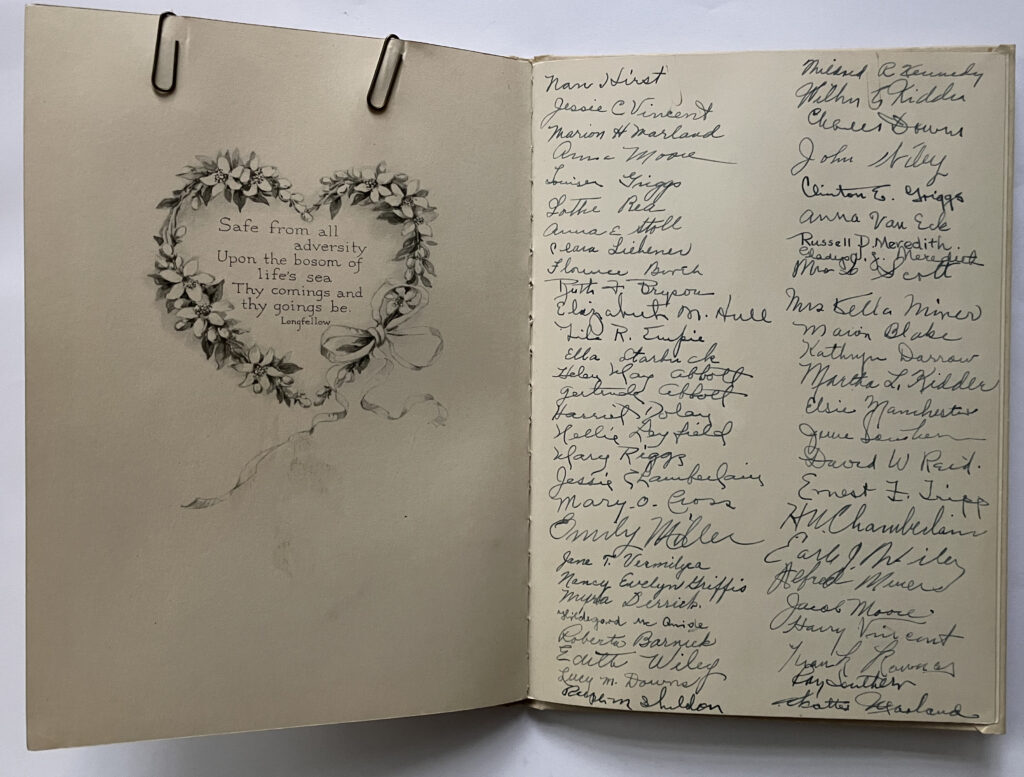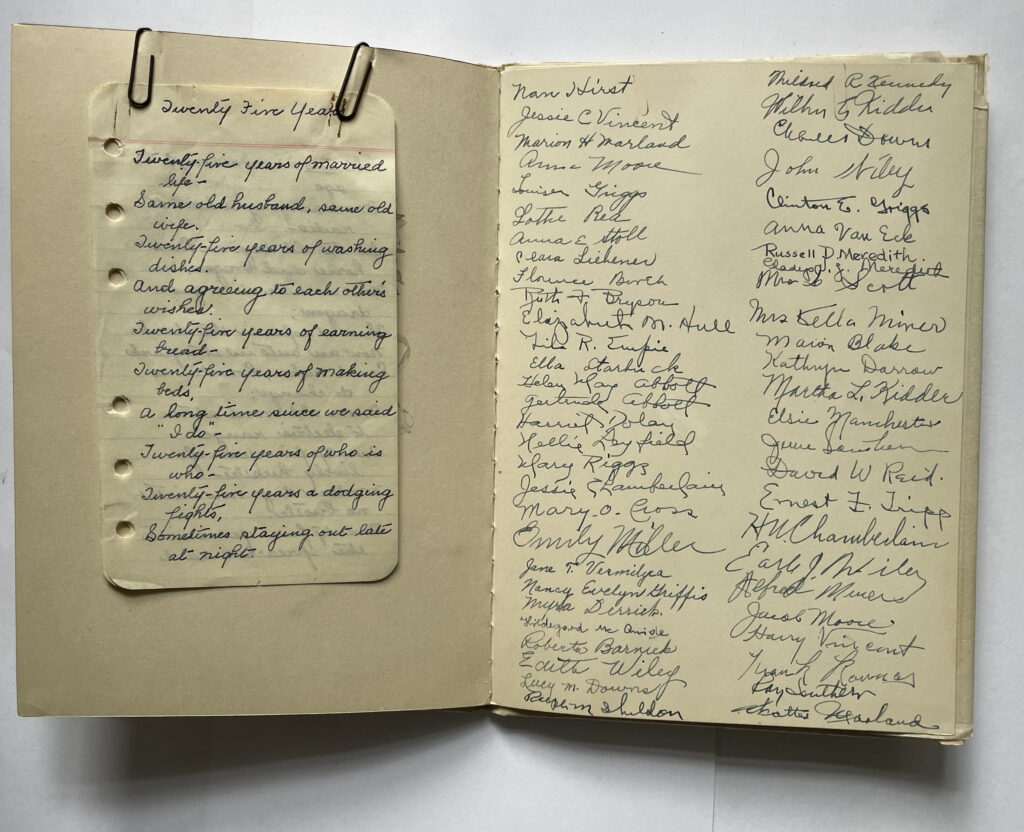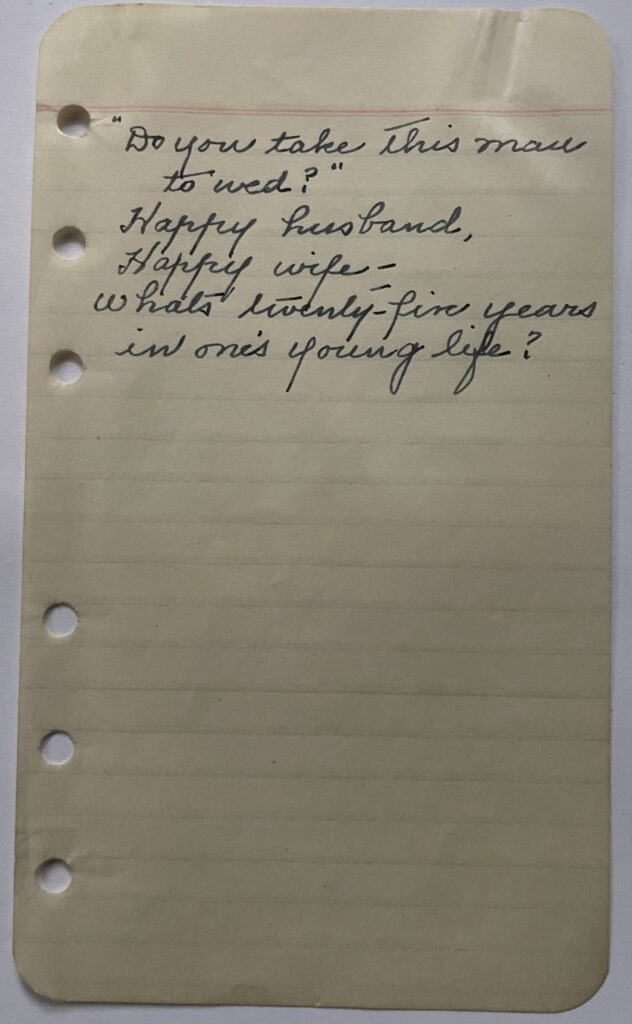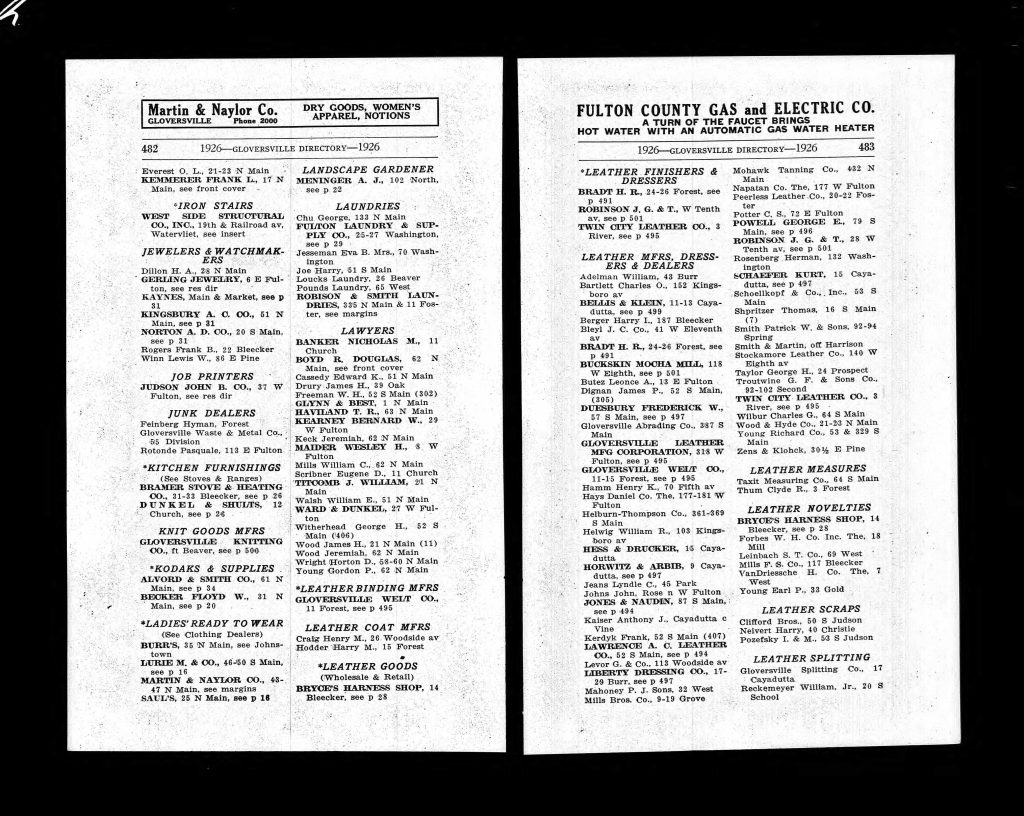One of challenging and more vexing aspects of viewing old family photographs is not knowing who is in a photo. A photograph is found among a relative’s cherished belongings. You know the photograph must have some significance to be saved for all these years. However, there is no hand written identification on the back to document when the photograph was taken and who is in the photograph. Sometimes you find a group photo with a few recognizable faces interspersed with ‘strangers’.
Whose eyes are looking back at you? They are the faces of strangers yet they may be related to you. If you are lucky, there might be other photos saved along with this puzzling photograph of strangers. You may attempt to look more closely at the faces to discern any similarities or a resemblance of someone in another photo that has documented names inscribed on the back of a photograph to tie them together.
At a certain point, rubbing your eyes, you put the magnifying glass down and start researching various background characteristics of the photo to anchor the photograph to a time and place. While this may not pinpoint who is in the photograph, it may reduce the range of possible relatives to consider when attempting to solve the mystery of who is in a photograph. [1]
The Photograph
The following photograph led me on a quest of discovering who were these two men looking at me with such serious looks on their faces..
The two gentlemen in the photo were young. Posing, looking regal, left arms angled in a similar fashion. Both were dressed in suits with bowler hats. Perhaps the suits, shoes and hats were props along with the backdrop and chairs.
“The Photograph”
Click here to view PDF version of photograph (allows ability to increase size and move in on specific areas of photograph)
When I received the metal, frameless photograph it was not stored with other photographs. I could not remember how I came into possession of the photograph. This exercise of trying to figure out who was in an ‘orphan’ photograph led me to a deeper appreciation of filing, managing and protecting old photographs. Although it is a constant, tedious process, cataloguing photos by source and date will ensure information about the photograph is not lost when they are ‘rediscovered’ in a box or folder. I learned my lesson.
Initially with nothing to guide me on discovering the identities of these young men, I relied on a number of sources to tease information out of the photograph and document the time period of the old photograph. The type of photographic technology used to make the photo will help place the photograph in a general time period. The clothes that the subjects are wearing and the type of background and furniture found in the photograph may also provide a clue of when the photograph was taken. [2]
Type of Photograph
The photograph of the two young men was on a piece of metal that appears to have been cut out of a frame or the frame was destroyed. It appears someone cut the edges of thee photograph at some point in time. Since it was made of metal, there is nothing on the back of the photograph. The piece of metal was three and a half inches long and about two and a quarter inches inches wide.

This four-lens, wooden bellows tintype camera was used for studio portrait photography in the 1860s during the Civil War era. Tintypes were popular inexpensive photographs This camera could make up to four identical images in one portrait sitting. [3]
The dimensions of the photograph and the nature of the metal suggest that. the photograph is a “Tintype” photo. The tintype method of photography was America’s first major popular contribution to the art of photography. It superceded the Ambrotype by the end of the Civil War and went on to become 19th-Century America’s favorite quick picture. Tintypes enjoyed their widest use during the 1860s and 1870s, but lesser use of the medium persisted into the early 20th century.
“The tintype photograph saw more uses and captured a wider variety of settings and subjects than any other photographic type. It’s like the elderly grandfather that saw everything. It was introduced while the daguerreotype was still popular, though its primary competition would have been the ambrotype.
“It began losing artistic and commercial ground to higher quality albumen prints on paper in the mid-1860s, yet survived for well over another 40 years, living mostly as a carnival novelty.” [4]
A tintype photograph is made by coating an iron plate (0.017 inches thick) with a light sensitive collodion silver mixture. It was made the same way as the Ambrotype, except that a thin piece of black enameled, or japanned iron was used in place of glass. Like the Ambrotype, the image is reversed. Ferrotypes were made from thumbnail size to as large as 11″ x 14″.
You can test if it is a tintype photo by using a magnet. If the magnet attracts to the photo, then you have a Tintype. In my case a magnet quickly attached to the photograph. It’s a tintype photograph. [5]
The tintype image has a similar appearance to the Ambrotype, which puts the collodion image on glass instead of a metal plate. The backs of tintype were lacquered to protect the exposed metal from rust and oxidation.
The metal used to support the tintype image was actually iron, not tin. The tintype is more properly called a ferrotype. According to one story, they came to be popularly known as “tintypes” because of the tin shears used to separate the individual images. Although many tintype photographs exhibit the same whitish gray image as the ambrotype, it can be easily distinguished because the magnet trick.
The tintype photo is not whitish grey like earlier tintype photographs but a darker ‘chocolate tinted’ color. This type of tintype photographic process was popular in America between 1870 and 1885.
“Brown or chocolate tintype images had a brief period of popularity from 1870 to 1885. In 1870 the Phenix (sic.) Plate Co. began making plates with a chocolate-tinted surface. It was said in a period journal, “created a sensation among the photographers throughout the country, and the pictures made on the chocolate-tinted surface soon became the rage”. In the 1870s the “rustic” theme made its debut in studio photography offering painted backgrounds, fake stones, wood fences and rural props. Neither the chocolate tint nor the rustic look are to be found in pre-1870 tintypes.” [6]
Style of Clothing & Props in Photograph
Based on an analysis of the clothing and props found in the tintype, it is believed that the photograph was taken in the late 1870’s.
Both of the gentleman’s well tailored outfits highlight many of the fashions of the 1870’s and 1880’s. Note the high waist coat and vest, the extremely narrow lapel on the sack coats with the high six button front and the curved front of the jacket. Consistent with how the jackets were worn in this era, the first button is only done on the suit.
Trousers are also tailored to a more slim style. There are still no creases in the front of his trousers as the press had not yet been invented. Both gentlemen are holding short bowlers with curled brims. [7]
Enlarged view of Shoes in Photograph

Men’s shoes of the 1870s had higher heels and a narrow toe. The shoes in the photograph appear to be Congress Gaiters. The congress boot (or Congress Gaiter) was very popular in the 19th and early 20th century. These below ankle boots became available around 1840, and were thought to be a version of the Balmoral boot, reputedly designed by Prince Albert, husband of Queen Victoria. When elastic material became commercially viable for use, it was used in new boot designs. The boot was made from soft kid leather. The elasticated sides provided both easy access and neat fit ably assisted by a cloth tab at the back of the heel of the boot. [8]
Enlarged view of Neck Wear in Photograph

One of the gentleman is wearing a narrow ribbon necktie. It is difficult to clearly see the necktie and the shirt collar on the gentleman on the right hand side in the photograph. It appears to be a style similar to one of many styles found in the 1870’s [9]
The chair that the individual in the right hand of the photograph is sitting on is a “fringe chair”. These were adjustable chairs made for photography studios. Introduced around 1864, they were popular through the 1870s. It became ‘old fashion’ in the late 1870s and is seldom seen after this time. [10]

Comparing the Photograph with Other Photographs
Originally I thought the was a photograph of the two young men were of individuals on my mother’s paternal side of the Hart family. I poured over family photographs that I had of the Hart family and could not match the two faces despite how hard I tried to force their images into other likenesses.
I enlisted the help of a distant cousin on the Hart side of the family who also shares my interest in genealogy. She gave me excellent sources to check and also poured over other old photographs in the attempt to match faces. Alas, we both agreed that these two men were not from the Hart side of the family.
I started to consider the possibility that the photograph was from another branch of the family. I may have misfiled this old photograph with the Hart family photographs. I started looking over old photographs of Griffis and Dutcher family members. The Dutcher branch of the family was Evelyn Dutcher Griffis’ paternal side of her family.
I started to look at a number of old photographs in my possession and came upon one that immediately caught my eye (no pun intended). It was a photograph of a young man (below) and on the cardboard back of the photograph was handwritten “John Dutcher” in my paternal grandmother’s (Evelyn Dutcher) handwriting.
Cabinet Card Photograph of John Dutcher Front and Back


Hamlin Photography was a photography business in Gloversville, New York. The owner of the business was Gary Hamlin. Gary B. Hamlin , lived at 18 Bleecker St, Gloversville, NY, and had his photography studio at 18 Bleecker Street. [11]
The photograph is an example of a Cabinet Card. Cabinet cards were popular between 1866 and the early 1900’s. They are easy to recognize because they are mounted on cardstock, often with an imprint of the photographer and location just below the photo. They are usually 4 inches by six and a half inches in size. (which is the size of the John Dutcher photograph). Details of a cabinet card, from the type of card stock to whether it had right-angled or rounded corners, can help determine the date of the photograph. Card stock that is square and of heavy weight card stock (like the photograph of John Dutcher) usually correlate with photographs in the 1880’s. [12]
Based on the card colors, borders on the photograph, the lettering below the photograph, and the characteristics of the back of the card photo, it would appear that this photograph was taken around 1885 – 1890. However, it has been noted the borders of cabinet cards with rounded corners and a rule of single line, such as that found on this photograph of John Dutcher, might suggest the photograph was taken between 1899 and 1896. [13]
Every face has numerous, distinguishable landmarks, the different peaks and valleys that make up facial features. Modern day facial recognition software defines these landmarks as nodal points. [14] Each human face has approximately 80 nodal points. Some of these measured by the facial recognition software are:
- Distance between the eyes;
- Width of the nose;
- length of the bridge of the nose;
- Depth of the eye sockets;
- The shape of the cheekbones;
- The length of the jaw line;
- Shape of the ears
I immediately saw similarities of various facial features of John Dutcher in this photograph, taken by Hamlin Photography from Gloversville, NY, with the Tintype photograph.
Comparison of Facial Features in the Two Photographs

Comparing the tintype photograph with the two photographs reveals striking similarities. Tintypes are usually a camera original, so the image is usually a mirror image, reversed left to right from reality. Sometimes the camera was fitted with a mirror or right-angle prism so that the result would be right-reading. However, in the Tintype of the two individuals it appears to be a micro image. John’s part in his hair is on the right side in the Tintype while in the cabinet card photograph it is on the left hand side.
I also found a photograph of John’s brother, Squire Dutcher, and his wife, Mary Jane Platts (below).
Photograph of Squire Dutcher and MaryJane Platts

I enlarged a portion of the photograph to get a better look at Squire’s face and compared the enlargement with an enlargement from the Tintype photograph.
Comparison of Facial Features in the Two Photographs
While the face is a bit fuller in the photograph with Mary Jane Platts (perhaps a little bit older than in the tintype photograph), the eyes, nose, mouth and jaw line in each of the photographs are comparable. While difficult to get an accurate glimpse, the ears also look similar.
Conclusion: The ‘Who’ and ‘When’ of the Photograph
It would appear that the two individuals in the tintype photograph are Squire and John Dutcher.
Squire and Mary Jane were married in 1883 [15] when Squire was 20 years old. Assuming the photograph of Squire and Mary Jane was taken before or after they were married, the photograph was taken around 1883-1884.
Squire Washington Dutcher was born July 8th, 1863, during the Civil War. His younger brother John E. (Edward?) Dutcher was born in 1866. Since Squire and Mary Jane were married around 1883, the photograph was probably taken around the time of Squire’s marriage. The timing is consistent with the period in which this type of tintype photographic process was popular. If the original photograph in this story was taken around 1880, Squire would have been 17 years old and his brother John would have been 14 years old.
The Two Brothers: Squire and John Dutcher
Squire and John came from a family of six children. Squire was the second oldest of the siblings and the oldest of three sons: Squire, John and Alonson (Alonzo). John was born three years after his older brother Squire. Allison was born in 1869.
All three brothers lived his entire lives in the Gloversville, New York area. Squire passed away on July 29, 1932. His younger brother John E. (Edward?) Dutcher passed away fours years before Squire on October 27, 1928. Squire died on July 29, 1932, roughly five months after his first great grandchild, James Dutcher Griffis, was born.
Not much is known of the third brother Alonson Dutcher. Family folklore, principally from Evelyn Dutcher Griffis, indicate, in her words, that “Alonzo was the ‘black sheep’ of the family”.
The family chart below provides a general outline of Squire and Johns’ family. I have extended the family ties to Harold And Evelyn Griffis to place their family relationships in context to Harold Griffis, one of the family tree locators I have used in these stories. .
Family of Squire and John Dutcher
Another Twist in Tintype Photographs
The photograph of Squire Washington Dutcher and Mary Jane Platts was in a “1960’s gold colored metal modern frame” that was in the possession of James Dutcher Griffis, Squire’s first grandchild. James D. taped three tintype photographs in the rectangular gold rimmed frame with oval matting for each of the photographs.
When I removed the photographs from the frame, it is apparent that each of the photographs are brown or chocolate tintype images.
Three Photographs in Frame

The photograph below is the photograph I used, but outside of the frame, to compare faces in the tintype of the two young men. As stated, this photograph could have been taken around 1883, around the time that Squire and Mary Jane were married. Given this type of tintype photograph, it places the photograph within the 1870-1885 time range of when the brown or chocolate tintype was prevalent and popular.
PHOTOGRAPH ONE: Squire Dutcher and MaryJane Platts Removed from the Frame
Click here to view PDF version of photograph (allows ability to increase size and move in on specific areas of photograph)
The second photograph (below) from the gold frame has three individuals in the photograph. It is apparent that two of the three individuals are Squire and Mary Jane.
PHOTOGRAPH TWO: Squire Dutcher, Jeannette Platts (?) and MaryJane Platts Removed from the Frame
Click here to view PDF version of photograph (allows ability to increase size and move in on specific areas of photograph)
Based on the clothes in the Photograph One and Photograph Two, Squire and Mary Jane are wearing the same clothing and the background wallpaper in the photographs are identical. The photographs were probably taken on the same day. This is apparent when viewing blown up portraits of Squire that are taken from each of these three tintype photographs. It appears that in the middle photograph, the image of Squire is a bit out of focus. However, Squire is clearly in each of the photographs.
Three Way Comparison of Profiles of Squire Dutcher in Three Tintype Photographs

The third person in the PHOTOGRAPH TWO is an enigma. I do not have a concrete clue as to who is this young lady. However, I believe I have an idea of who is the third person in the photograph through “a process of elimination“.
Blow Up of Third Person in Tintype PHOTOGRAPH TWO
I think the young lady is one of Mary Jane’s sisters: Jeannette Platts. A review of available Cabinet Card photographs of the three sisters in the Dutcher family led me to the conclusion that none of them look like the young lady in the photograph. Also the ages of the sisters at 1880-1883, an approximate year when the photograph may have been taken, did not appear to match the perceived age of the young lady in the photograph. Julia , Squire’s older sister, would have been much older in 1880-1883 than the young lady in the photograph. Rose Dutcher would have been around 8-11 years old and Myrtle Dutcher would have been around 5-8 years of age at the time of the photograph.
The Three Dutcher Sisters
I also examined available photographs of the sisters of Mary Jane Platts. Mary Jane had two younger sisters. Unfortunately I only have access to photographs for Lenora Dutcher. There are no available photographs of Jeannette Dutcher. Lenora would have been 10-13 years old and perhaps younger than the young lady in the photograph. Even though we do not have available photographs of Jeannette Platts to compare facial features, her age possibly fits the age (13-15 years old) of the young lady in the photograph.
Hence, through process of elimination, I am guessing that Jennette Platts is in the photograph with her sisters and her new brother-in-law Squire.
The Platts Sisters

The PHOTOGRAPH THREE in the three picture frame is also a bit of a mystery. A close inspection of the photograph makes one wonder what the photographer was offering the gentleman in the photograph. Both photographer and those photographed considered it perfectly appropriate to arrange reality for the photographic occasion.
The use of props and backdrops certainly were used to elevate the importance of the sitter in the photograph. Photographers posed their sitters to lean against chairs, furniture and other items. The individuality of the sitter is often lost in these contrived poses. But this photo is indeed a curiosity. The individual is standing in front of a wallpaper set up that makes the individual appear to be in a room with an opening to an outside area with vines appearing at the outside archway. He is casually learning on a sawed off tree with another one on his right side. Each of these seed off trees are next toddy configured branches. I can not tell if they are rustic chairs or just an odd amalgam of branches.
This photograph certainly conforms to the “Brown Period” of tintype photography. During this period “rustic” photography made its debut with its painted backgrounds, fake stones, wood fences and rural props. Neither the chocolate tint nor the rustic look are to be found in pre 1870 tintypes.
With his right arm akimbo, the gentleman is gritting on a cigar with a top hat. Quite a pose and look! However, I find it difficult to state that this is Squire in this jaunty pose.
PHOTOGRAPH THREE: Alonzo Dutcher (?)

Click here to view PDF version of photograph (allows ability to increase size and move in on specific areas of photograph)
An inspection of the three face shots of Squire Dutcher in the prior photographs with the image from PHOTOGRAPH THREE suggests that it is not Squire in the photograph with the top hat. Squires eyes were typically more deep set in photographs than those found in the “top hat” photograph. The face is more square than the oval face with a broad forehead of Squire. The nose is similar to Squire’s as is the chin and mouth. While we do not have any photographs of Alonzo Dutcher for comparative purposes, I suspect that this photograph is of Alonzao Dutcher. Alonzo would have been around 14 years old.
Comparison of Four Face Shots
Nothing is certain and perhaps new information will be found in time. For the present moment, I believe we have “new” photographs of Jeannette Platts and Alonson (Alonzo) Dutcher!
Sources
Feature Image: Blown up portions of photographs comparing the facial features of Squire Dutcher and John Dutcher.
[1] Joan L.Severa, Dressed for the Photographer: Ordinary Americans and Fashion, 1840 – 1900, Kent: Kent State University Press, 1995, The 1870’s and 1880’s, Page 292 – 453
Tracee Hamilton, How to Date your Old Photographs, ARP Website, https://www.aarp.org/relationships/genealogy/info-11-2011/dating-old-photos.html
Nancy Price, Genealology Research : Dating Vintage Photographs by Clothing and Hairstyles, April 7, 2010, https://www.sheknows.com/living/articles/814584/genealogy-research-dating-vintage-photographs-by-clothing-and-hairstyles-1/
Katherine Howells and Ioannis Vasallos, The National Archives, How to Date Family Photographs, 2 April 2020, Page accessed 13 Feb 2023, https://blog.nationalarchives.gov.uk/how-to-date-family-photographs/
Lisa Lisson, My Favorite 10 Resources for Dating Old Photographs , Are You My Cousin? Genealology, April 28, 2016, https://lisalisson.com/top-10-resources-for-dating-old-photographs/
Mary Harrell-Sesniak, How to Date Old Ancestor Photographs with Early Photo Types, Oct 14, 2013, Genealology Bank, how-to-date-old-ancestor-photographs-with-early-photo-types.html
Genealogy Sleuthing: How to Date Old Family Photos – Part I, Legacy Tree Genealogists, https://www.legacytree.com/blog/date-old-family-photos
Genealogy Sleuthing Part II: Using Women’s Fashion to Date Old Photos, Legacy Tree Genealogists, womens-fashion-date-old-photos https://www.legacytree.com/blog/womens-fashion-date-old-photos
Matt P, How Old Are My Photos?, April 29, 2021, EverPresent, Learning Center, Blog, https://everpresent.com/how-old-are-my-photos/
[2] History of Photography Methods/Processes, Physical Properties, Photos Made Perfect: Restoring Family History One Photo at a Time, http://www.photosmadeperfect.com/Genealogy_%20Corner/Photo%20Dating%20Page%20Top%20pg/AAPhotoDatingIntro%20Top%20Pg.htm
Mary Harrell-Sesniak, How to Date Old Ancestor Photographs with Early Photo Types, Oct 14, 2013, Genealology Bank, how-to-date-old-ancestor-photographs-with-early-photo-types.html
Other Methods of Photo Dating, Photos Made Perfect, http://www.photosmadeperfect.com/Genealogy_%20Corner/Photo%20Dating%20Other%20Methods/ABOtherMethods%20of%20Photo%20Dating.htm
Katherine Howells and Ioannis Vasallos, The National Archives, How to Date Family Photographs, 2 April 2020, Page accessed 13 Feb 2023, https://blog.nationalarchives.gov.uk/how-to-date-family-photographs/
[3] Source of photograph: : Four-Lens Tintype Camera, National Museum of American History, https://americanhistory.si.edu/collections/search/object/nmah_1145576
[4] Gary Clark, Tintype Photographs, Phototree.com, http://www.phototree.com/id_tin.htm
Gary Clark, Identifying Photograph Types, Phototree Blog, http://www.phototree.com/identify.htm
[5] Photo Dating 101, Photos Made Perfect, http://www.photosmadeperfect.com/Genealogy_%20Corner/Photo%20Dating%20Page%20Top%20pg/AAPhotoDatingIntro%20Top%20Pg.htm
Tintype, City Gallery, http://www.city-gallery.com/learning/types/tintype/
TinType, Wikipedia, This page was last edited on 17 January 2023, https://en.wikipedia.org/wiki/Tintype
Colin Hardy, How to Spot a Ferrotype, also Known as a TinType (1855 – 1940s), 25 May 2013, https://blog.scienceandmediamuseum.org.uk/find-out-when-a-photo-was-taken-identify-ferrotype-tintype/
[6] Tintype, City Gallery, http://www.city-gallery.com/learning/types/tintype/
See also: Tintype Identifying Timeline Tables

History of Photography Methods/Processes, Physical Properties, Photos Made Perfect: Restoring Family History One Photo at a Time, http://www.photosmadeperfect.com/Genealogy_%20Corner/Photo%20Dating%20Page%20Top%20pg/AAPhotoDatingIntro%20Top%20Pg.htm
[7] Men’s Hat’s By Decades, Photos Made Perfect, http://www.photosmadeperfect.com/Genealogy_%20Corner/Photo%20Dating%20Page%20Top%20pg/AAMens%20Fashions%20Page.htm
Men’s Portrait Gallery 1880, Historical Emporium, https://www.historicalemporium.com/1880-victorian-photo-gallery.php
Identifying Old Photos by Clothing: 1860s – 1870s, MyCanvas Blog, Oct 12, 2018, https://mycanvasblog.com/identifying-old-photos-clothing-1860s-1870s/
[8] 1880s in Western fashion, Wikipedia, This page was last edited on 15 March 2023, https://en.wikipedia.org/wiki/1880s_in_Western_fashion
“In the Fall of 1878 in New York, Frank O’Neil was arrested for trying on a brand new pair of Congress Gaiters, then waltzing out of the store at 24 Hudson Street without making payment. The police caught him shortly thereafter, ensuring his place in history.”
Congress Gaiter – Black Faux Leather, Historical Emporium: Authentic Products and Old Fashioned Service, https://www.historicalemporium.com/store/008039.php
“It was known by several names and originated just after 1837 as part of the Balmoral fashion surge.”
19th Century (1800s) Men’s Boots and Shoes, Leavey Foundation for Historic Preservation, Inc, http://www.ushist.com/19th-century_mens_boots_shoes.shtml
Cameron Kippen, Foot Talk, Blog, November 22, 2021 http://foottalk.blogspot.com/2006/01/a-brief-history-of-congress-boots.html
[9] Necktie gallery, 1870s in Western fashion, https://www.wikiwand.com/en/1870s_in_Western_fashion
1870s in Western fashion, Wikipedia, This page was last edited on 22 February 2023, https://en.wikipedia.org/wiki/1870s_in_Western_fashion
[10] Gary Clark, Week’s Photograph – November 26, 2012, PhotoTree Blog: Analysis of Old Photographs, http://www.phototree.com/case_112612.htm
Gary Clark, Case Study – September 9, 2013, PhotoTree Blog: Analysis of Old Photographs, http://www.phototree.com/case_090913.htm
[11] Gary B. Hamlin , photographer lived at 18 Bleecker St, Gloversville, NY, and had his photography studio a few doors down the street at 18 Bleecker Street. Page 115, Image 59, Gloversville City Directory, NY, 1888, Ancestry.com. U.S., City Directories, 1822-1995 [database on-line]. Lehi, UT, USA: Ancestry.com Operations, Inc., 2011.


Hamlin Photography, Advertisement in the Gloversville NY Directory 1888, Page 45, Image 2, Gloversville City Director, 1888, Ancestry.com. U.S., City Directories, 1822-1995 [database on-line]. Lehi, UT, USA: Ancestry.com Operations, Inc., 2011. Page 45 Image 20 – Hamlin Photographer
[12] Kimberly Powell, Cabinet Card, March 3, 2017, Thought Co., https://www.thoughtco.com/identifying-and-dating-cabinet-card-1422271
Jeremy Rowe, Dating Card Mounted Photographs, Jeremy Rowe Vintage Photography, DBA Arizona Views Vintage Photography, Inc, https://www.vintagephoto.com/reference/dating.html
Colin Harding, 5 Sep 2013, How to Spot a Cabinet Card (1866 – c.1900), Science + Media Museum, https://blog.scienceandmediamuseum.org.uk/find-out-when-a-photo-was-taken-identify-a-cabinet-card/
[13] Kimberly Powell, Cabinet Card, March 3, 2017, Thought Co., https://www.thoughtco.com/identifying-and-dating-cabinet-card-1422271
David Cyclebac, Cabinet Card, Judging the Authenticity of Photographs, http://www.cycleback.com/photoguide/mounted.htm
[14] Kevin Bonsor & Ryan Johnson, How Facial Recognition Software Works, How Stuff Works, https://electronics.howstuffworks.com/gadgets/high-tech-gadgets/facial-recognition.htm
[15] Actual documentation on Squire Dutcher and Mary Jane Platts’ marriage are not available. However, in a 1900 U.S. Census, it was reported that the couple were married for 17 years. Original data: 1900 United States Federal Census, Gloversville Ward 3, Fulton County, New York, Roll T623 1036; Page 7A, enumeration District 10, Gloversville City Sheet No 7 Line 26 and 27; Ancestry.com. 1900 United States Federal Census [database on-line]. Provo, UT, USA: Ancestry.com Operations Inc, 2004.Image 13 or 38


